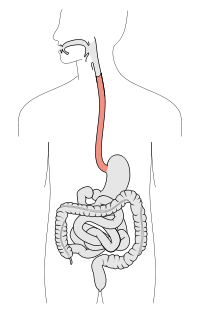
Photo from wikipedia
IMPORTANCE Sarcopenia has been identified as an independent risk factor for dysphagia. Dysphagia is one of the most important and prognostically relevant complications of acute stroke. The role of muscle… Click to show full abstract
IMPORTANCE Sarcopenia has been identified as an independent risk factor for dysphagia. Dysphagia is one of the most important and prognostically relevant complications of acute stroke. The role of muscle atrophy as a contributing factor for the occurrence of poststroke dysphagia is yet unclear. OBJECTIVE To assess whether there is a correlation between age and muscle volume and whether muscle volume is related to dysphagia in acute stroke patients. DESIGN, SETTING, AND PARTICIPANTS This retrospective, single-center study included 73 patients with acute ischemic or hemorrhagic stroke who underwent computed tomography angiography on admission and an objective dysphagia assessment by Fiberoptic Endoscopic Evaluation of Swallowing within 72 hours from admission. With the help of semiautomated muscle segmentation and 3-dimensional reconstruction volumetry of the digastric, temporal, and geniohyoid muscles was performed. For further analysis, participants were first divided into 4 groups according to their age (<61 years, n = 12; 61-75 years, n = 16; 76-85 years, n = 28; ≥86 years, n = 17), secondly into 3 different groups according to their dysphagia severity using the Fiberoptic Endoscopic Dysphagia Severity Scale (FEDSS) (FEDSS 1 and 2, n = 25; FEDSS 3 and 4, n = 32; FEDSS 5 and 6, n = 16). MAIN OUTCOME AND MEASURE Correlation of muscle volumes with age and dysphagia severity. RESULTS Muscle volumes of single muscles (except for geniohyoid and the right digastric muscles) as well as the sum muscle volume were significantly and inversely related to dysphagia severity. We found a significant decline of muscle volume with advancing age for most muscle groups and, in particular, for the total muscle volume. CONCLUSIONS Apart from features being determined by the acute stroke itself (eg, site and size of stroke), also premorbid conditions, in particular age-related muscle atrophy, have an impact on the complex pathophysiology of swallowing disorders poststroke.
Journal Title: Journal of the American Medical Directors Association
Year Published: 2017
Link to full text (if available)
Share on Social Media: Sign Up to like & get
recommendations!